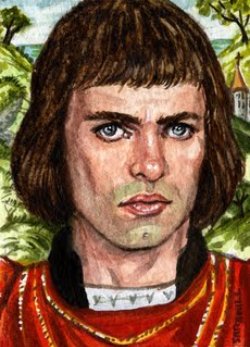
Piers Gaveston, 1st Earl of Cornwall
Born: Unknown
Died: June 19, 1312
Kenilworth, Warwickshire, England
Gaveston in History
Arnaud de Gabaston, the father of Piers Gaveston, was a loyal subject of King Edward I, and Piers himself would begin his career in the same fashion, serving in campaigns to France and Scotland as early as 1297. By 1300, Gaveston became a member of the household of Prince Edward, the heir to the throne. The two developed an extremely close relationship which helped Gaveston gain favor in the king's eyes. However, Gaveston would desert the king during the Scottish campaign of 1306. Additionally, the king saw Gaveston as a bad influence on his son, and the two quarreled violently when the elder Edward learned that the prince had attempted to award the county of Pontheiu to his friend. Therefore, the king, somewhat reluctantly (as he seemed to be fond of his son's friend) exiled Gaveston.
Edward I died and was succeeded by the prince as Edward II in July of that year, and Gaveston was immediately recalled from his exile in France and became the king's favorite. He was created Earl of Cornwall and was married to the king's nice Margaret de Clare, co-heiress to the Earl of Gloucester. The nobility does not seem to have had any major objections to Gaveston's presence at court at first, but they were humiliated by him when he defeated several of them at a jousting tournament and angered them even further when he was made regent of the kingdom in the king's absence. In addition, Gaveston felt the need to display an arrogant attitude and to show off the new wealth he had achieved as the king's favorite. The lords, led by the Earl of Lincoln, pressed the king to dismiss Gaveston and govern the realm effectively (which he was not doing). Edward II was forced to agree, and Gaveston was sent into exile for the second time (May 1308).
Gaveston settled in Ireland where he became the king's lieutenant and, surprisingly, proved to be a competent and effective leader in a realm that was always difficult to manage. Edward II recalled his favorite to England in early 1309, and he continued his arrogant ways, this time making up demeaning nicknames for all the lords that were opposed to him. The following year, at the urging of the lords, the king was forced to allow the formation of the lords ordainer, a group of twenty-one nobles and clerics whose assignment was to draw up reforms in the realm. One of the primary elements of the ordinances was that the king had to shun flatterers and accept good council, meaning they wanted Gaveston gone again. The king had no choice but to agree, and Gaveston once again went into exile (November 1311); this time, the royal favorite was back within two months. When the nobles heard of his return, they immediately pursued him and ultimately captured him at Scarborough Castle after they had besieged it. The Earl of Pembroke, a moderate noble, agreed to treat Gaveston fairly and to not make any decisions until consulting the king. Gaveston was put in Pembroke's custody, but one day when the earl was away, the Earl of Warwick seized the favorite and brought him to a mock trial where he and the Earl of Lancaster (the new leader of the resistance) had him convicted and beheaded. Edward II was devastated by his favorite's death and vowed revenge on the men responsible, which he would accomplish ten years later when Lancaster too would be executed.
Gaveston in Marlowe
Appears in: Edward II
Piers Gaveston appears in Edward II as the king's favorite and is viciously hated by the nobility. He is created Earl of Cornwall, the king's secretary and is married to the king's niece Margaret. Though the nobles agree at one point to treat him favorably, they long for his exile, and finally, his death. Gaveston is captured by the lords and put in the custody of the Earl of Pembroke. However, the Earl of Warwick gains possession of him and promptly has him executed.
References
Hamilton, J. S. ‘Gaveston, Piers, earl of Cornwall (d. 1312)’, Oxford Dictionary of National Biography, Oxford University Press, Sept 2004; online edn, Jan 2008 [http://www.oxforddnb.com/view/article/10463, accessed 7 June 2010]